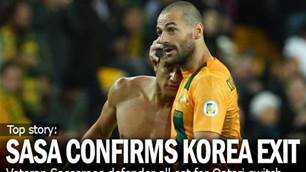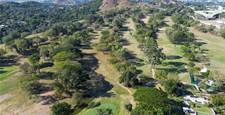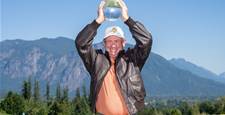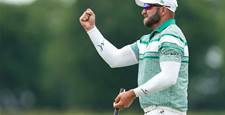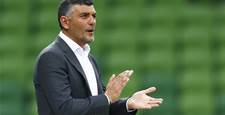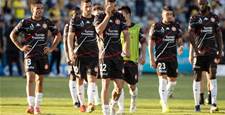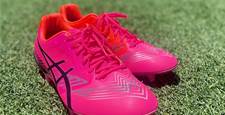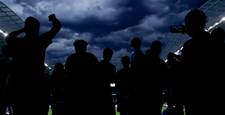SOCCEROO hard-man Sasa Ognenovski on his sharp rise to prominence.
From state league defender to Socceroo regular, ACL-winning captain and Asian Player of the Year in just six years. Sasa Ognenovski on peaking late, if he hates Pim Verbeek, Korean karaoke and how Wolverine would play him on screen! Richard Scott chats to the giant defender to find out how it was all possible...
At 32, Sasa Ognenovski is something of a late bloomer. Rewind just six years and the hard-boiled 1.95m Socceroos centre-back was lining up for, now defunct, amateur outfit Fawkner-Whittlesea Blues in the Victoria Premier League. Since then, his footballing ascent has been nothing short of meteoric.
Signed for then-named Queensland Roar in 2006, Sasa transferred to Adelaide United in 2008 making a combined total of 61 A-League appearances, playing in the 2008 AFC Asian Champions League Final [finishing second to Japan’s Gamba Osaka] and earning a runners-up medal to Melbourne Victory in the 2008-2009 A-League grand final. His impressive form even saw him voted 2008’s second best Macedonian footballer of the year, behind Inter Milan striker Goran Pandev [currently on loan at Napoli].
Despite the plaudits, the Melbourne-born defender was routinely ignored by renowned A-League detractor and former Australia coach Pim Verbeek for international selection. Dismayed, Sasa put his hand up for the Republic of Macedonia, receiving an international call-up against Moldova in 2009 but, maddeningly, he found himself unable to play due to eligibility issues.
The same year Sasa became a target for both Japanese and South Korean league clubs, kicking off a bidding war between the K-League’s Seongnam Ilhwa Chunma and FC Seoul for his signature.
He signed with Seongnam on a two-year deal in January 2009, captaining the side to AFC Champions League victory in his second season, taking out Man of the Match for the final and being voted the tournament’s Most Valuable Player. 2010 also saw the Seongnam skipper become the first Aussie to be crowned Asian Footballer of the Year – quite a feat for a defender – and his inclusion into the K-League’s BestXI for that season.
Ignoring Ognenovski was virtually impossible by this stage and his patience was finally rewarded when the new Socceroo head coach Holger Osieck handed Sasa his first cap in a friendly against 2010 African Cup of Nations champions Egypt in Cairo at the end of 2010. He’s since made a total of 10 appearances in the green and gold, including every match of the 2011 AFC Asian Cup – partnering skipper and defensive stalwart Lucas Neill – and playing every minute of that Asian cup final against Japan in Qatar.
Now a first-choice Socceroo and in the form of his life, the reigning Asian Player of the Year may seem to have come out of the blue for many Australian football fans but for the man himself it’s been a very long time coming. And to think, we could quite easily have lost him to the Macedonian national team were it not for a bureaucratic oversight.
Still, Macedonia’s loss is our gain as we spoke to the veteran defender about donning the green and gold for the first time, how long he’s got left in him, his Korean karaoke skills and having Wolverine play him on film.
Sasa, you’ve been called the “late developer’s late developer”. How does it feel to achieve veteran status as a relative newcomer to the Socceroos squad?
Everything that’s happened to me so far has just been fantastic. I’ve been given an opportunity much later than some. At the same time, I first played overseas in Greece [for Panachaiki GE] at 21, 22 but had to come back home after just six months because the club went bankrupt. Things like that you just can’t predict. My life may have gone the other way completely. But it’s been a great ride and to come out of nowhere to become part of the Socceroos now is amazing.
You’ve also been dubbed “Scary Sasa”, “Ogre” and, bizarrely, “The Ogg Monster”. Do others see you as a hard-man? An Aussie Vinnie Jones perhaps?
I like to attack the ball. Not many defenders really attack the ball with as much aggression as me. I’m not short [1.95m] and I always want to win the ball. I never shirk a challenge. Sometimes I’ll win the ball through sheer will than anything else. But Vinnie Jones? Not so much. Vinnie focused his aggression on the man, I concentrate on the ball. I’ll never deliberately intimidate a player. Still, it can’t be much fun seeing me go in [for a tackle] at a 100 miles-an-hour.
Continues on next page...
Which centre-backs did you admire growing up?
More a playmaker than a defender, but [former Germany international and current Bulgaria manager] Lothar Matthäus was my hero. For his will to win games, more than anything. To this day I’ve got that fight in me never to lose. I learnt that ‘Never Say Die’ attitude from [watching] Matthäus, and that’s probably how I ended up where I am today.
How about defenders today?
Nesta. He’s been nothing but dependable for Milan over the years. Just a fantastic defender. The way he reads the ball. The way he reads the game. He’s never beaten one-on-one. Such an elegant player too – I’m sort of not. But Nesta, he’s the complete central defender.
Obviously you’ve had a busy couple of years: cementing your spot in the national team, winning the AFC Champions League captaining K-League’s Seongnam IIhwa Chunma and being named 2010 Asian Football of the Year. What’s been your highlight so far?
I’d have to say debuting for my country against Egypt [November, 2010] without a doubt. The moment I put on that top in Cairo I knew. To be finally recognised after all that time was my proudest moment.
So what’s next for your career? There are rumours of the Bundesliga.
Yes, well. I have to choose wisely at the age I am now. I’m 32, and I’m not a free player. I’ve signed a three-year contract in Korea. I’d love to get to Europe eventually, but clubs aren’t too keen on paying for 32-year-old players.I’ve had interest from some clubs in England, championship and lower-Premiership clubs, but the truth is I don’t have enough caps for that sort of move yet, especially for this next transfer window. We’ll have to wait and see on all of that moving forward, but right now I’m happy in Korea.
And why Korea?
I had a bunch of offers after the way I was playing for Adelaide, some from Japan and some from South Korea. The coach of one of the Korean teams [Seongnam Ilhwa Chunma], Shin Tae-Yong, was once part of the team with me at the Roar and knew me, as a player and as a person. So that made the decision easier. I had a great relationship with the boys at Adelaide so it was important for me to find a coach that knew me and respected me the same, instead of a new manager who gives you three or four games to impress. Also the club is based out of Seoul which is a great place to live and to train; the facilities are great. And it’s a great place for my family. Seoul as a city is buzzing.
So are you a rock star in Korea?
Ha! Not really. The Japanese boys get hassled a lot more on the street than me. The K-League isn’t massive. It gets pretty packed in the stadiums when the national team is playing. But it’s still quite a small league with only three or four clubs really challenging for the title. At best you’ll see crowds of 15,000 to 20,000. A-League crowds are much larger as a whole, much stronger supporter-wise.
Physically, are you a giant over there?
You’d be surprised! Some of the Korean boys are pretty tall actually, and really big too. Not as strong as me, of course [laughs]. They might be a little flimsier but there’s some big boys over there, that’s for sure.
You started every game and played the full 90 minutes in Australia’s 1-0 defeat to Japan in the 2011 Asian Cup Final. It must have been quite a slap in the nuts...
It was very frustrating, yes, to come that close to being the best [national] team in Asia. I’ve had that feeling at club level in the Asian Champions League before. We could have won it too. It would’ve been the icing on the cake for me but it wasn’t to be. Luck just didn’t favour us that night.
What would you say was missing?
Nothing! We had three or four great chances and we didn’t take them. I didn’t feel we were lacking in anything though. Perhaps if Josh [Kennedy] was there. I mean, attacking wise Harry [Kewell] and Tim [Cahill] performed brilliantly throughout the tournament, but perhaps if we had the option of throwing on Josh, even from the bench, having the big guy up there might have helped us, but he was injured. Overall, I’d say the whole team was sound. Defensively, to only concede two goals over the whole tournament, speaks volumes for our team, not just the back four. The whole team was committed to the end.
Continues on next page...
How disappointed were you to miss out on international selection for so long?
I was frustrated more than disappointed. I felt overlooked. It was as if nobody knew of me. Even after playing for Adelaide [and finishing runners-up to Melbourne Victory in 2008-2009] I think five or six of the boys got called up: Jamieson, Mullen, Barbiero, Reid, Birighitti... I was the only one to miss out. It got me frustrated with the set-up. I felt like my form had warranted a call-up, but I was repeatedly overlooked.
We take it you’re not a fan of Pim then?
Look, it was his decision. Personally I think he took an underdone squad to South Africa and that lost us a spot in the quarter finals. But it’s every coach’s prerogative to make the best choices from the best players they have available.
So how’s your relationship with Holger?
Great! Obviously, he’s handed me this opportunity. I’ve missed out on playing in the last few games while he tests out a few players in my spot and that’s fair. You’ve got to give the other lads a chance too. But as for holding down that position in the future, I can only hope. So long as I keep fit and healthy and my form warrants it, then why not?
Who are your closest mates in the Socceroos squad?
A fair few, but the whole team, to be honest. You can easily sit down at a table and talk to any of those boys for hours. They’re all genuine, good people. All down to earth. You can literally talk to anyone and everyone. It’s important for the Australian national team. We can’t really afford to have any disharmony in our camp.
Fair enough. We were hoping to start a Dutch-style rift. And finally, is there the danger that Sasa Ognenovski has potentially hit his peak too late in life?
The way my body feels right now I’d say I’ve got at least two or three solid years left in me. Like I said, I’m 32 but my body is fine-tuned from the way I play in Korea. They’re very fit over there. Plus, in over three or four years I must have missed about ten games all up. Each of those were minor niggles, just a rolled ankle or whatnot. The body feels good. I back up game after game in Korea and I never miss training. I’ve got a couple of years in me, at the very least, and I can only improve.
So, hypothetically, what would be the ideal way to spend those last two years?
My dream, although I doubt it could come true, is to go to the Bundesliga and then go to the World Cup. Realistically me playing in Germany is not as obtainable a goal as us [Australia] going to the World Cup finals [in 2014], but if I’m still playing...
You must be pretty excited about the prospect of making it to a World Cup with the Australian team.
Of course! The experience of playing for Australia in the Asian Cup was amazing. To go to my first World Cup at 35 and get amongst it with the best players in the world on the world stage is very, very exciting.
And in Brazil too! There’s bound to be plenty of temptations for you and the boys to get up to mischief there...
I think Holger would have something to say about that. No doubt he’ll have us all under lock and key. It would be a good place to blow off some steam though...
It might have taken him longer than most but better late than never. Sasa’s not the first late bloomer in football history. Arsenal goal-scoring legend Ian Wright was still playing amateur football for Dulwich Hamlet three months short of turning 22 when he was scouted by former Crystal Palace boss Steve Coppell. His last appearance was for Burnley at 37 in 2000. Chelsea’s Didier Drogba, 33, wallowed in French Ligue 2 at the relatively late age of 21. And Lazio’s Miroslav Klose, also 33, reportedly once worked as a builder and bricklayer while playing for German association club FC 08 Homburg at 21. Yet Sasa, just a few months off turning 33 himself, seems to be just getting started. And, perhaps unfairly, offering hope for every amateur footballer nearing 30 in the country.
He’s officially the best player in Asia, a club captain, and just this year a Korean FA Cup winner with Seongnam Ilhwa Chunma. At national level, Sasa now has the backing of his manager and a reputation as a dependable professional on the field – a strong, commanding presence at the back with a penchant for scaring the living daylights out of opponents. Australia will be seeing plenty more from the big number four. Pim Verbeek must rue the day he overlooked the Ogre.
This article appeared in the February 2012 issue of Australian FourFourTwo magazine. To buy back copies of this issue call 03-8317-8121 with a credit card to hand.
The current edition of Australian FourFourTwo has just gone on sale in newsagent across the country, or you can subscribe here
Related Articles
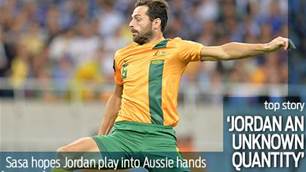
Sasa calls for Aussie attacking mentality
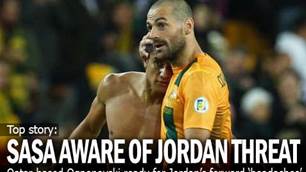
Ognenovski Braces For Dangerous Jordan
